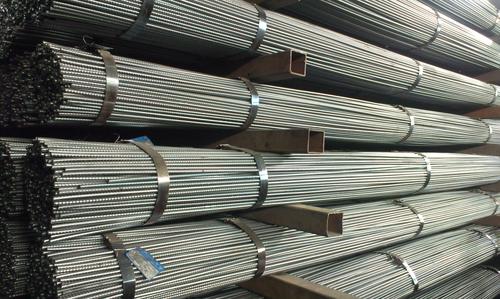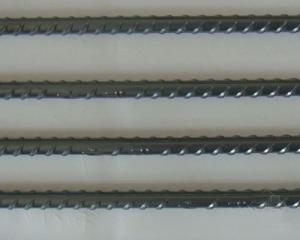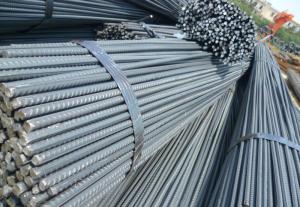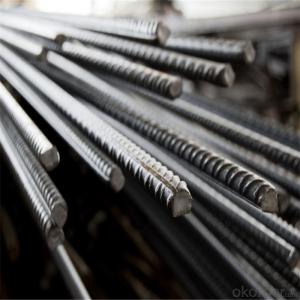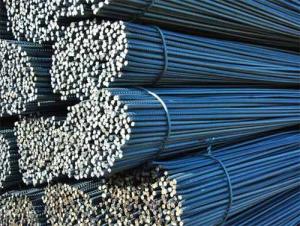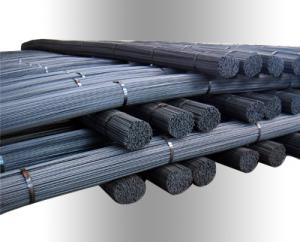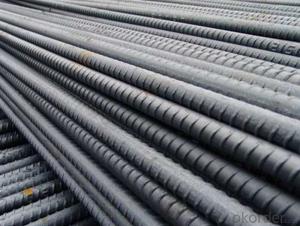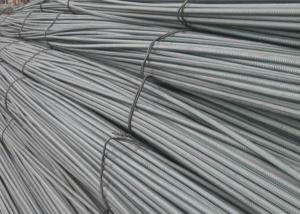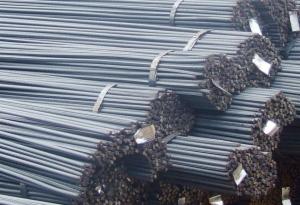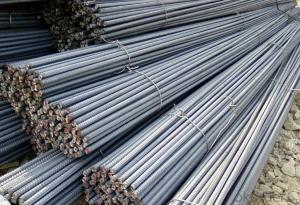Cold Rolled Rebar 16mm
- Loading Port:
- China Main Port
- Payment Terms:
- TT OR LC
- Min Order Qty:
- -
- Supply Capability:
- -
OKorder Service Pledge
Quality Product, Order Online Tracking, Timely Delivery
OKorder Financial Service
Credit Rating, Credit Services, Credit Purchasing
You Might Also Like
Cold Rolled Techniques
Yield Point: 545-565mpa
Deformed bar is widely used in buildings, bridges, roads and other engineering construction. Big to highways, railways, bridges, culverts, tunnels, public facilities such as flood control, dam, small to housing construction, beam, column, wall and the foundation of the plate, deformed bar is an integral structure material. With the development of world economy and the vigorous development of infrastructure construction, real estate, the demand for deformed bar will be larger and larger.
- Q: How are steel rebars stored and handled on construction sites?
- Steel rebars, also known as reinforcing bars, are an essential component in construction projects that require reinforced concrete structures. These rebars are typically stored and handled on construction sites in a systematic and organized manner to ensure their safety and efficient use. To begin with, steel rebars are often delivered to construction sites in bundles or bundles tied using wire or binding materials. Once the rebars are unloaded from the delivery truck, they are usually stored in designated areas known as rebar yards or cages. These areas are specifically designed to accommodate the length, size, and weight of the rebars, ensuring they are kept off the ground and protected from moisture, dirt, and any potential damage. In the rebar yard, rebars are commonly stacked horizontally and grouped according to their size, length, and grade. This arrangement facilitates easy identification and accessibility when needed for construction. Additionally, rebars are often separated by spacers or wooden blocks to prevent direct contact between them, reducing the risk of corrosion or tangling. When it comes to handling steel rebars, construction workers must prioritize safety and follow specific guidelines. Personal protective equipment, such as gloves and safety boots, should be worn to prevent injuries and ensure a secure grip on the rebars. In some cases, workers may use lifting equipment, such as cranes or forklifts, to move and transport rebars to different areas of the construction site. During transportation, rebars should be secured properly to prevent any shifting or falling, which could lead to accidents. Workers should also avoid dragging rebars on the ground, as this can cause damage to the bars or deform their shape, compromising their structural integrity. It is crucial to note that steel rebars should be inspected before use to ensure they meet the required specifications and are free from any defects. Rusty or damaged rebars should be discarded or repaired, depending on the severity of the issue. In summary, steel rebars are stored and handled on construction sites with utmost care and attention. Proper storage in designated rebar yards, correct grouping and separation, and adherence to safety guidelines during handling contribute to the successful and efficient use of steel rebars in construction projects.
- Q: What is the corrosion resistance of steel rebars?
- The corrosion resistance of steel rebars is generally high due to the presence of a protective oxide layer on the surface of the steel. However, in certain environments, such as those with high levels of moisture or exposure to corrosive substances, the rebars may be susceptible to corrosion. Therefore, additional measures such as proper concrete cover, epoxy coating, or galvanization are often employed to enhance the corrosion resistance of steel rebars.
- Q: What is the maximum length of a steel rebar available in the market?
- The maximum length of a steel rebar available in the market can vary depending on the manufacturer and the specific needs of the construction industry. However, the most commonly available lengths of steel rebar range from 20 feet (6 meters) to 60 feet (18 meters). These lengths are typically preferred due to transportation and handling constraints. However, it is important to note that custom lengths can be specially ordered from manufacturers to meet specific project requirements.
- Q: What is the role of steel rebars in tunnel shaft construction?
- The role of steel rebars in tunnel shaft construction is crucial for ensuring the structural integrity and strength of the tunnel shaft. Steel rebars, also known as reinforcement bars, are used to reinforce the concrete structures in the tunnel shaft. The main purpose of steel rebars is to provide additional tensile strength to the concrete. While concrete is strong in compression, it is relatively weak in tension. By placing steel rebars within the concrete, the tensile forces are transferred from the concrete to the steel, effectively increasing the overall strength and stability of the structure. In tunnel shaft construction, steel rebars are typically placed in a grid pattern throughout the concrete walls, floor, and ceiling of the shaft. This grid pattern helps distribute the tensile forces evenly and prevents the concrete from cracking or crumbling under the pressure. Steel rebars also play a crucial role in preventing the concrete from expanding or contracting due to temperature changes. By providing reinforcement, they help to control the potential for cracking or structural damage caused by thermal expansion and contraction. Additionally, steel rebars can improve the durability and longevity of the tunnel shaft. They enhance resistance against external forces such as earthquakes, ground settlements, and water pressure. Moreover, they can reinforce the tunnel shaft against potential impacts or collisions, ensuring the safety of the structure and its occupants. In summary, the role of steel rebars in tunnel shaft construction is to reinforce the concrete structures, increase their tensile strength, prevent cracking, control thermal expansion, enhance durability, and provide resistance against external forces. Their presence is essential for creating a strong and reliable tunnel shaft.
- Q: How are steel rebars measured and priced in the market?
- Steel rebars are typically measured and priced in the market based on their weight per linear foot or meter. The weight is usually expressed in pounds or kilograms. The pricing is influenced by factors such as the current cost of steel, market demand, and any additional processing or transportation costs.
- Q: What are the guidelines for the proper curing of concrete with steel rebars?
- The guidelines for the proper curing of concrete with steel rebars include ensuring a moist and controlled environment for the concrete to cure. This can be achieved by covering the concrete with a plastic sheet or using curing compounds. It is important to avoid rapid drying or exposure to extreme temperatures during the curing process. Additionally, regular monitoring of the curing process and proper hydration of the concrete are crucial to ensure the rebars bond effectively with the concrete and achieve maximum strength.
- Q: How are steel rebars cut and bent on-site?
- Steel rebars are cut and bent on-site using specialized tools and equipment. The process typically involves the following steps: 1. Measurement: The rebars are measured according to the required length and dimensions specified in the construction plans. This is crucial to ensure accuracy and precision in the bending and cutting process. 2. Cutting: Rebars can be cut using different tools such as manual rebar cutters, hydraulic shears, or portable electric cutters. These tools are designed to provide clean and precise cuts without causing damage to the rebars. The rebars are positioned securely, and the cutting tool is applied to the marked area, resulting in the desired length. 3. Bending: Once the rebars are cut to the required length, they are bent using rebar benders. These machines have various attachments and rollers that can shape the rebars according to the desired angle and radius. The rebars are carefully positioned and secured in the bender, and the machine exerts force to bend them to the specified shape. 4. Quality control: After cutting and bending, the rebars undergo quality control checks to ensure they meet the required specifications. This may involve visual inspections, measurements, and testing to verify the accuracy of the dimensions and the quality of the cuts and bends. It is important to note that skilled workers, such as ironworkers or steel fixers, are typically responsible for the on-site cutting and bending of rebars. They have the expertise to interpret construction plans, use the appropriate tools, and ensure that the rebars are cut and bent accurately to meet the project's needs.
- Q: How do steel rebars contribute to the overall resistance against natural disasters?
- Steel rebars contribute to the overall resistance against natural disasters by reinforcing structures such as buildings, bridges, and dams. They enhance the strength and stability of these structures, making them more resistant to earthquakes, hurricanes, and other natural calamities. Steel rebars increase the structural integrity, prevent collapse, and distribute the force of the disaster, reducing the extent of damage and protecting lives and property.
- Q: How do steel rebars affect the overall cost-effectiveness of a structure?
- Steel rebars play a crucial role in enhancing the overall cost-effectiveness of a structure. These reinforcement bars are widely used in construction projects to provide strength, durability, and stability to concrete structures. By incorporating steel rebars, the lifespan of a structure is significantly increased, reducing the need for frequent repairs and maintenance, thereby lowering long-term costs. One of the key benefits of using steel rebars is their ability to reinforce concrete, making it capable of withstanding heavy loads and forces. This reinforcement prevents cracks and structural failures, ensuring the longevity of the structure. As a result, the need for costly repairs and replacements is minimized, resulting in cost savings over the lifespan of the structure. Moreover, steel rebars enhance the overall structural integrity of a building, reducing the risk of damage caused by natural disasters such as earthquakes and high winds. This increased resilience not only saves lives but also reduces the financial burden of rebuilding or repairing a damaged structure. In addition to their strength and durability, steel rebars provide cost-effectiveness during construction itself. These bars can be prefabricated off-site, allowing for efficient and streamlined construction processes. This reduces labor costs, accelerates construction timelines, and minimizes material wastage, leading to overall cost savings. Furthermore, steel rebars can be recycled, making them an environmentally friendly choice. The recycling process not only reduces the demand for raw materials but also lowers production costs, contributing to the cost-effectiveness of a structure. In summary, steel rebars enhance the cost-effectiveness of a structure by increasing its longevity, reducing maintenance and repair costs, improving resilience to natural disasters, optimizing construction processes, and promoting environmental sustainability. By incorporating steel rebars into construction projects, developers and owners can maximize the return on investment while ensuring the safety and longevity of the structure.
- Q: Can steel rebars be used in structures subjected to chemical exposure?
- When structures are exposed to chemicals, it is important to consider the type and concentration of the chemicals involved. Steel rebars can be used in these structures, as steel is generally resistant to many chemicals. However, certain corrosive substances can degrade the rebars and compromise their integrity. In such situations, it is crucial to choose the appropriate grade of steel rebars that offer enhanced resistance to chemical corrosion. Stainless steel rebars, for example, contain a higher proportion of chromium and other alloying elements, making them highly resistant to a wide range of chemicals. These rebars are commonly used in structures exposed to aggressive chemical environments, such as wastewater treatment facilities, chemical plants, and marine structures. Furthermore, protective coatings can be applied to steel rebars to further enhance their resistance to chemical exposure. Coatings like epoxy or polymers create a barrier that prevents direct contact between the rebar and the chemical, minimizing the risk of corrosion. These coatings are commonly used in structures exposed to chemicals like sulfuric acid or chloride ions. To ensure the long-term durability and safety of structures in chemically aggressive environments, it is important to consult with structural engineers and corrosion specialists. They can help determine the most suitable type of steel rebars and protective coatings for a specific chemical exposure scenario. Proper design, material selection, and maintenance practices are essential in these environments.
Send your message to us
Cold Rolled Rebar 16mm
- Loading Port:
- China Main Port
- Payment Terms:
- TT OR LC
- Min Order Qty:
- -
- Supply Capability:
- -
OKorder Service Pledge
Quality Product, Order Online Tracking, Timely Delivery
OKorder Financial Service
Credit Rating, Credit Services, Credit Purchasing
Similar products
Hot products
Hot Searches
Related keywords

